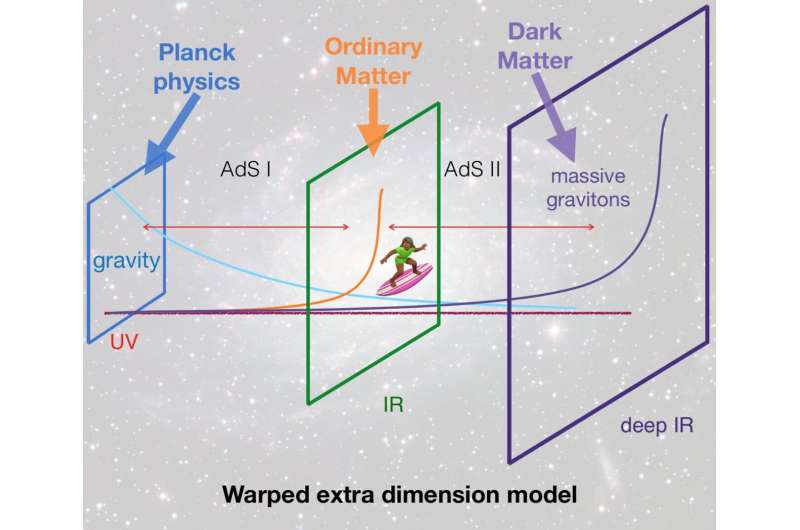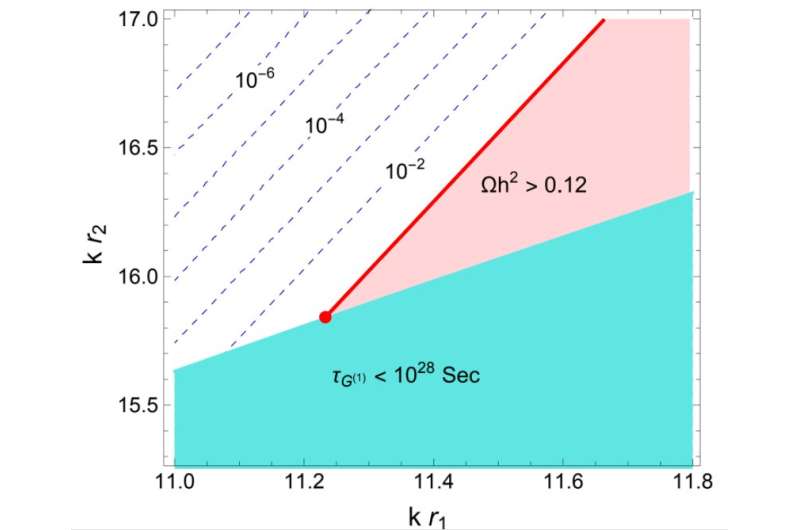Could massive
gravitons be viable dark matter candidates?
by Ingrid Fadelli , Phys.org

Cartoon of the warped extra-dimensional model, where the
position along the extra space direction is represented by the horizontal axis.
The ordinary space-time is represented by the orthogonal screens. Ordinary
matter we are made of is localised on the middle screen, while Dark Matter
mainly lives on the right screen. Credit: Cai, Cacciapaglia & Lee.
Today, many research teams worldwide are trying to detect
dark matter, an invisible substance that is believed to account for most of the
matter in the universe. As does not reflect or emit light, its presence has
been indirectly revealed via its gravitational interactions with visible
matter.
So far, the most promising dark matter candidates are
axions, neutrinos, and weakly interacting massive particles. Recently, however, some physicists also
started investigating the possibility that another type of hypothetical
particles, massive gravitons, could be viable dark matter candidates.
Theory suggests that massive gravitons were produced
during collisions between ordinary particles in the hot and dense environment
of the early Universe, in the few instants following the Big Bang. While theories
predict their existence, these particles have so far never been directly
detected.
Researchers at Korea University and University of Lyon
have recently carried out a theoretical study exploring the possibility that
massive gravitons could be good dark matter candidates. The results of their
theoretical calculations were published in a paper in Physical Review Letters.
"Our study started by looking at extra dimensions,
particularly warped extra
dimensions, which have
been studied a lot in the past 20 years," Giacomo Cacciapaglia, one of the
researchers who carried out the study, told Phys.org. "When gravity
propagates in this invisible space, it materializes massive gravitons. Their
coupling to ordinary matter is very weak, being of gravitational origin."

Relic density of the massive graviton in
the parameter space of the warped model. The points along the red line
reproduce the observed Dark Matter in the Universe, while the shaded regions
are excluded. Credit: Cai, Cacciapaglia & Lee.
The process through which massive gravitons would
theoretically be produced is extremely rare. For this reason, the rate at which
these particles are produced would be significantly lower than the rate of
production of "ordinary" particles. Cacciapaglia and his colleagues
Haiying Cai and Seung Lee wondered whether enough massive gravitons were
produced in the early universe for them to be considered a good dark
matter candidate.
"By computing the production rate of these
particles, we discovered that some processes are enhanced below the scale where
the Higgs boson generates masses for the ordinary particles, 1 picosecond after
the Big Bang," Cacciapaglia said. "We showed that this enhancement is
enough to create the right amount of dark matter in the form of massive
gravitons with masses below the MeV."
The calculations performed by Cai, Lee and Cacciapaglia
show that instead of being associated with unknown physics occurring shortly
after the Big Bang, the production of massive gravitons is most effective below
the energy scale in which Higgs bosons reside. Higgs bosons are elementary
particles that carry the Higgs field, the field that gives mass to fundamental
particles such as electrons and quarks.
"This draws a direct connection between the physics
studied at the Large Hadron Collider in Geneva and the early Universe physics
of gravity and Dark Matter," Cacciapaglia said. "Our results imply
that gravitational dark matter is produced 1 picosecond after the Big Bang, at
a time when particle physics is well described by the current theories."
In the future, the results gathered by this team of
researchers could inspire new studies and calculations exploring the production
of massive gravitons in the universe. Meanwhile, Cacciapaglia and his
colleagues plan to build on the theoretical model introduced in their paper,
while also evaluating other dark matter candidates.
"We now plan to investigate other features of a
concrete model in warped extra dimension that we sketch in the article,"
Cacciapaglia added. "We are particularly interested in the role played by
a scalar particle called radion and on the potential testability at current and
future particle colliders."
Reference
“Could massive gravitons be viable dark matter
candidates?”, Phys.org, last modified March 23, 2022, accessed March 25, 2022, https://phys.org/news/2022-03-massive-gravitons-viable-dark-candidates.html